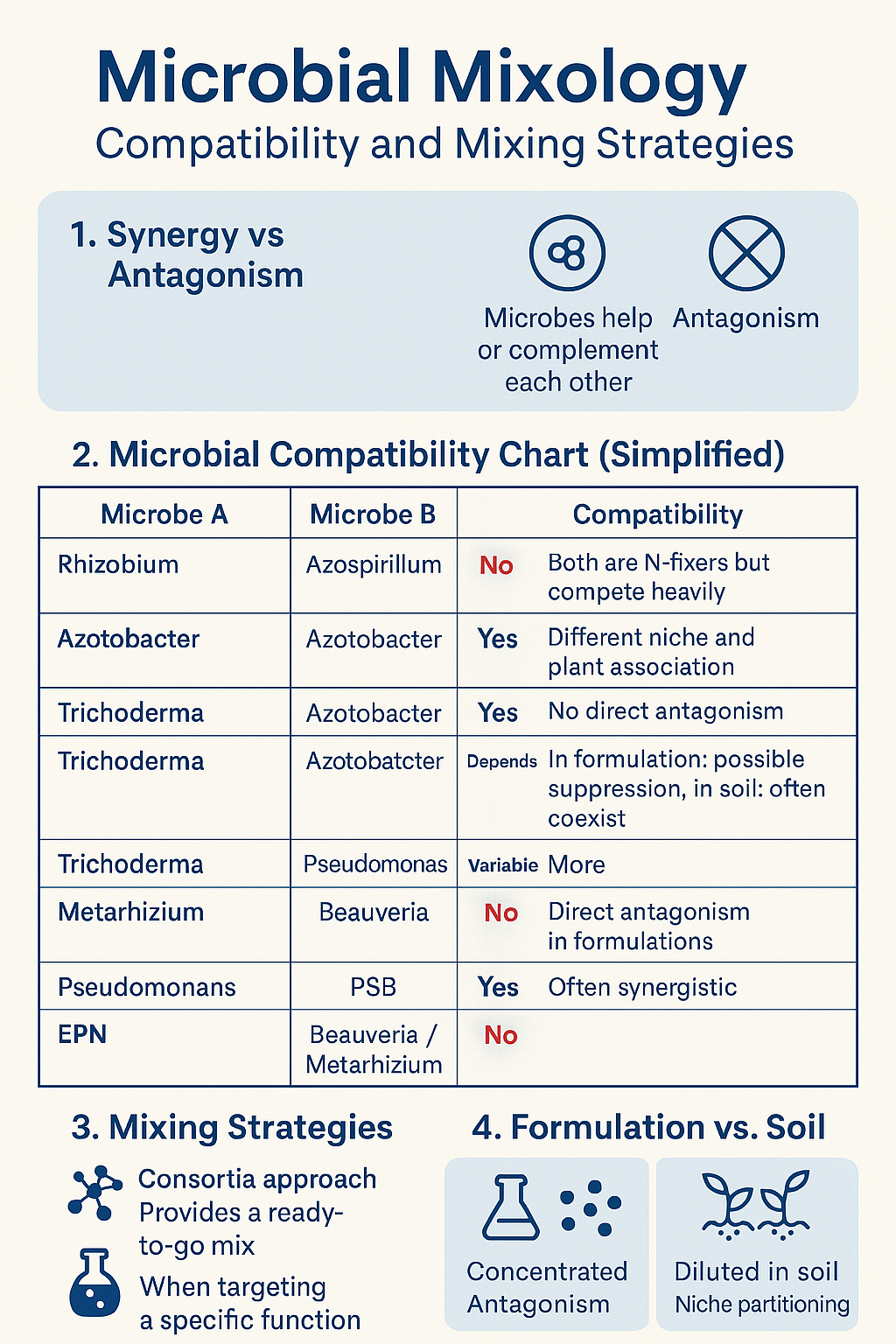
That’s like asking if all relatives can live in the same house peacefully.
Some will cooperate, some will tolerate, and some will fight like it’s Diwali at the in-laws’ place.
In this blog, we’ll unpack:
Synergy vs. Antagonism – What does it really mean?
Microbial Compatibility Chart – Friends, foes, and frienemies
Should you apply one at a time or as a consortia?
Soil vs. Formulation – Why antagonism is different in the field
Final recommendation
Synergy means the microbes help each other survive or amplify their functions.
Antagonism means one microbe suppresses, inhibits, or outright kills the other.
But here’s the nuance:
Most studies on synergy/antagonism are in vitro — in lab conditions
In soil, real-world complexity changes everything: space, food, moisture, predation, pH, temperature, etc.
So don’t panic just because two microbes seem “antagonistic” in the lab — they may both survive in soil just fine, in different niches.
| Microbe A | Microbe B | Compatibility | Notes |
|---|---|---|---|
| Rhizobium | Azospirillum | ❌ No | Both are N-fixers but compete heavily |
| Rhizobium | Azotobacter | ✅ Yes | Different niche and plant association |
| Azotobacter | PSB (Bacillus) | ✅ Yes | No direct antagonism |
| Trichoderma | Azotobacter | ⚠️ Depends | In formulation: possible suppression; in soil: often coexist |
| Trichoderma | Pseudomonas | ⚠️ Variable | Both aggressive, use with caution |
| Metarhizium | Beauveria | ❌ No | Direct antagonism in formulations |
| Pseudomonas | PSB (Bacillus) | ✅ Yes | Often synergistic |
| EPN (Steinernema) | Beauveria/Metarhizium | ❌ No | Different modes, different targets – still better applied separately |
There are two schools of thought:
Provides a ready-to-go mix: N-fixers + P-solubilizers + K-mobilizers + Pseudomonas
Great for early-stage or confused users
Useful in soils with poor diversity
Helps kickstart biological activity fast
Use when: You want a balanced input without precision targeting.
Ideal when you want to target a specific deficiency or function
Useful for seasoned farmers or advanced users
Allows more control over timing and dosage
Use when: You know exactly what your soil or crop needs.
Our view?
If in doubt, go for consortia. Nature will sort out the rest. Focus on good practices rather than overthinking combinations.
Microbes are concentrated
No food, no space, no buffers
Antagonism shows up strong
Dilution happens
Niche partitioning occurs
Weather, soil texture, and plants buffer interactions
Coexistence is more common
That’s why Trichoderma may suppress Pseudomonas in a lab, but they may coexist fine in soil, especially at root level.
Bottom line:
Don’t assume that lab-based antagonism equals field failure.
| Strategy | When to Use |
|---|---|
| Consortia mix | New users, confused cases, early-stage soils |
| Single-strain | Experienced farmers, specific deficiencies |
| Avoid mixing | Rhizobium + Azospirillum, Metarhizium + Beauveria |
| Apply separately | Biofertilizers vs. Biofungicides – space out by 3–5 days |
| Soil modifies everything | Don’t over-judge based on lab antagonism |
Coming up in next blog
We’ll cover crop-wise microbial advisory – when and what to use for major crops like wheat, paddy, sugarcane, tomato, potato, pulses, etc.
There was this interesting discussion I had with Mr Prateek
The teaser of Self Running Soil Revolution for an investment
The effectiveness of any microbial product depends not just on
Mitrasena (Army of friends) is global brand of Biowall Agrihealth Pvt Ltd. Mitrasena products & protocols enables seamless transition to non-toxic farming by concurrently offering Excellent Protection, Higher Productivity & Profit and, Ease of use.
We are a DIPP recognized Startup working for non-toxic crop protection. We are driven by a highly passionate and professionally competent team.
MitraSena © 2025 | All rights reserved | Innovatively Designed and Built by Social Mukul Media
Have any query about bulk orders? Get in touch with us.